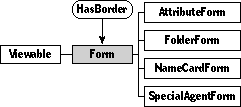Defined in Card.Def Inherits from Viewable, HasBorder

When you create a package that consists of a stack of cards, you might want to have viewable objects that appear on more than one card. To do this, you can create a form, place the objects that you want to share in the form, and then make each card refer to that form. The shared objects will be drawn on every card that uses the form.
Every card uses exactly one form, but a form can be used by any number of cards.
Remember that if the documentation and the software (especially the definition files) disagree, always trust the software.
You can find information relevant to the Form class in the sections describing classes Card and FormElement.
If your package contains a stack of cards, it must also include at least one form object. The usual way to create the stack, cards, and form is to copy an existing package that includes a stack. Using the Magic Cap software itself, you can modify the form by adding and removing objects. You can use the "put in background" and "put in foreground" coupons to move objects between the card and the form (background is an old name for form).
Each card is associated with a form. The form specifies objects that are shared by more than one card. When a card is drawn on the screen, the objects in the card's form are also drawn. Although the form objects are shared across cards, each card has its own data for the shared items. For example, a text field object in a form will be drawn with every card that uses the form, but every card can have its own text that appears in the text field object. The data for shared form items is kept in the card's extra data area.
Classes can define whether their objects store per-card data when placed in forms. Classes whose objects store per-card data should mix in the FormElement class.
A form can be associated with an image object. If a form has an image, the system draws the image in the upper left corner of the form. Usually the form's image is nil.
Instantiate: sometimes Subclass: rarely Call its methods: rarely
If your package consists of a stack of cards, you must create at least one form. As mentioned earlier, you'll probably make your stack and at least one card and form by copying an existing package. If your stack includes different logical groups of cards that share different sets of viewable objects, you can use a different form for each group of cards.
Class Form defines very few methods. The only method that you're likely to call is the one that returns the form's viewables that have different data on each card. Viewables that are on the form but have different data on each card, such as text field objects and switches, are called form items.
Most of class Form's methods are called by other parts of the system. You'll rarely have to call any methods of class Form directly.
The Form class has the following methods that you might call:
| Method | Description |
| FormItems | Return form viewables that have per-card data |
| DrawCardBackground | Draw the form elements on the card |
| GetOrMakeAgent | Return an agent for a telecard |
The Form class has the following methods that you might override:
| Method | Description |
|---|---|
| AttachToCard | Initialize prior to displaying or printing |
| DetachFromCard | Clean up after displaying or printing |
The Form class defines the following fields:
| Field | Type | Description |
|---|---|---|
| Inherited from SingleLinkable | ||
| next | Object | Next item in view list |
| Inherited from Linkable | ||
| previous | Object | Previous item in view list |
| Inherited from Viewable | ||
| superview | Viewable | Container for this object |
| subview | Viewable | Object contained by this object |
| relativeOrigin | Dot | Origin relative to superview |
| contentSize | Dot | Size of content rectangle |
| viewFlags | Unsigned | Property settings |
| labelStyle | TextStyle | Text style of object's label |
| color | Color | Color of object's content |
| shadow | Shadow | Shadow drawn with object |
| sound | Sound | Sound associated with object |
| Inherited from HasBorder | ||
| border | Border | Frame drawn around object |
| Defined by Form | ||
| image | Image | Image drawn in corner of form |
| formItems | Viewable | List of shared items with per-card data |
operation FormItems(): Viewable Call: sometimes Override: rarely
Call FormItems to get an object list that contains the items in the form that store per-card data. FormItems simply returns the value of the form's formItems field.
operation AttachToCard() Call: sometimes Override: always
AttachToCard is available to do any initialization required your form requires before it is displayed or printed. The basic Form class does not define this method. If you want to use it, you will have to override it. This method is called by Card_SummonForm. See the section on class Card for more information.
operation DetachFromCard() Call: sometimes Override: sometimes
DetachFromCard is available to do any clean-up required after your form is displayed or printed. As with AttachToCard, you'll have to override this method ifyou want to use it. Card_DismissForm calls this method. See the section on class Card for more information.
operation DrawCardBackground(canvas: Canvas; clip: Path), noFail Call: sometimes Override: rarely
To be written.
operation GetOrMakeAgent(): Object Call: sometimes Override: sometimes
By default, GetOrMakeAgent returns a standard courier agent (StandardCourier_). Class Telecard calls Form_GetOrMakeAgent in its definition of GetOrMakeAgent.
Version note: More information on agents and cards will appear in future chapters on telecard-related classes. We're expanding the information highway to better serve you!